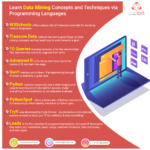METHODS USED FOR QUALITATIVE DATA COLLECTION
Methods Used For Qualitative Data Collection
Data plays an important role in any research or study conducted. It aids in bringing about a breakthrough in the respective field as well as for future researches. The collection of data is carried out in two forms viz: Qualitative Data and Quantitative Data which includes further bifurcation under it.
What is Qualitative Data?
Qualitative research can be defined as the method of research which focuses on gaining relevant information through observational, open-ended and communication method. They are more exploratory which concentrates on gaining insights about the situation and dig a bit deeper to find the underlying reason. The central idea behind using this method is to find the answer to Why and How rather than How many. Data gathered during a qualitative research is what is termed as qualitative data.
What is the purpose?
A qualitative data is non-numerical and more textual which
comprises mostly of images, written texts, recorded audios and spoken words by
people. Moreover, one can conduct qualitative research online as well as
offline too. Apart from this, the varied purpose of qualitative research is as
follows:
– To examine the purpose or reason for the situation
– Gain an understanding of the experience of people
– Understanding of relations and meaning
– Varied norms including social and political as well as contextual and
cultural practice which impact the cause.

What are the different methods of Qualitative Research Applied?
Moving ahead let’s look at the various methods that are applied in Qualitative research which is used to come to a relevant conclusion.
Surveys
Surveys are the commonest method used for collecting data to develop an
informed hypothesis or conclusion. It is deemed to be more beneficial when used
for obtaining information by asking open-ended questions which makes the
individual render their point of view or opinion over a certain topic or
situation. These can further be divided into two types which are a paper survey
and online survey.
- Paper Survey
Paper Survey comprises of questionnaires. These include open-ended questions and short questions in addition to a detailed answer by respondents. It is used to collect information about a certain issue from a large sample size. - Online Surveys
This is carried out in the form of a web survey developed using software or uploaded online on the website. Google survey form is the commonest method used to collect data through online surveys. Additionally, unlike a paper survey, an online survey is known to have a far wider reach which can be taken up by individuals anywhere anytime.
Observation
Observation is yet another most opted method for collecting qualitative
data. This includes observing the behavior of the person and recording the
events either in the form of notes, audio, or video. It aids in the process,
reaction as well as individual behavior of how they interact, communicate with
each other. The researcher herein is completely immersed in the situation to
reach a logical conclusion. Observation includes two main methods which are.
Covert and
Overt
In a covert method, the researcher/ observer keeps his purpose
concealed, without letting anybody know that they are conducting the
observation. On the other hand, an overt method is where everyone is well aware
of them being observed. This includes attending a wedding ritual and using a
video recorder or camera to record and capture what is happening around.
Interviews
This is one of the most opted and trusted methods of qualitative
data collection. It includes direct interaction and face-to-face conversation
between two people. Herein, an interview questionnaire is designed by the
researcher to gain insight about the individual’s knowledge or perception
surrounding a certain topic, issue or situation. Here, the questions can be
more open-ended, Structured Interviews or Unstructured Interviews or informal depending on individual beliefs, experience and
perspectives.
Focus Group Discussions
Here, the interviewer may target a group of 8-10 people, the
size of the sample is subject to differ based on the requirement put forth by
the researcher. Furthermore, each participant is given an equal chance to put
across their view on how they perceive a certain situation, with the freedom to
agree and disagree with each other’s opinion.
Conclusion
The qualitative data collection method is one of the best
methods used for identifying the behavior, the pattern of thinking, studying a
situation and issues thereby making it the best technique. In conclusion, the
above-listed methods are used to conduct a qualitative data analysis to enhance
the credibility and integrity of the data collected.

 Previous Post
Previous Post